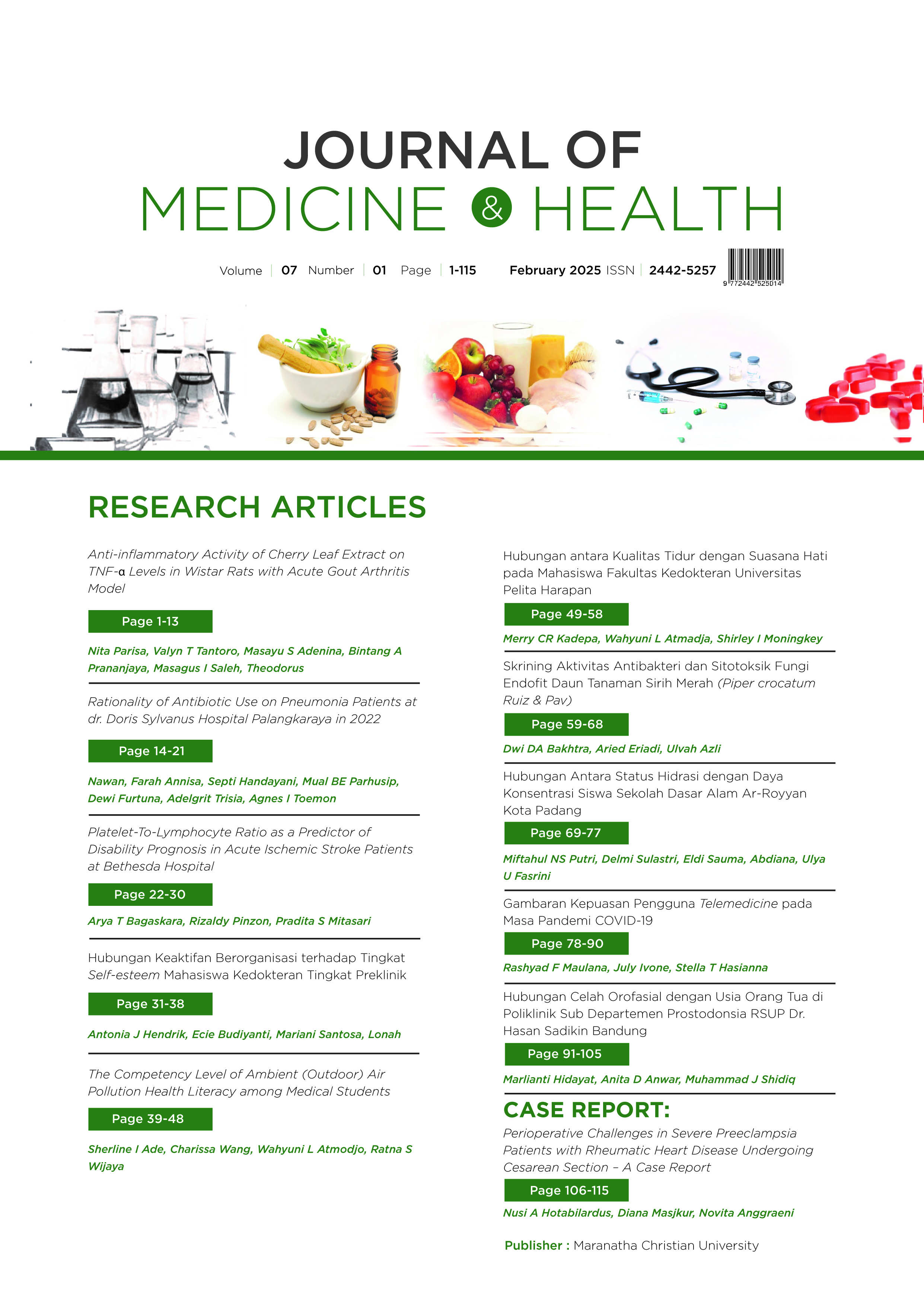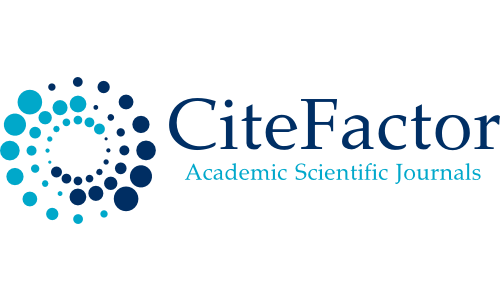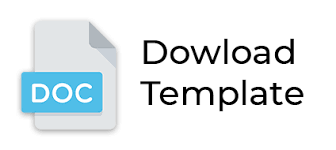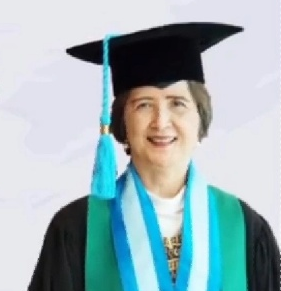Gambaran Kepuasan Pengguna Telemedicine pada Masa Pandemi COVID-19
DOI:
https://doi.org/10.28932/jmh.v7i1.8494Keywords:
telemedicine, telehealth, COVID-19, pandemi, kepuasan pasienAbstract
World health organization (WHO) menetapkan status pandemi Coronavirus disease-2019 (COVID- 19) pada tanggal 11 Maret 2020. Jumlah kasus dan kematian yang sempat meningkat di tahun 2021menyebabkan masyarakat memilih untuk tidak pergi ke fasilitas layanan kesehatan. Penyesuaian pelayanan kesehatan dengan telemedicine masih dianggap baru di masyarakat. Tujuan penelitian ini adalah mengevaluasi kepuasan masyarakat terhadap layanan konsultasi telemedicine selama pandemi COVID-19. Penelitian ini merupakan studi deskriptif dengan pendekatan cross-sectional menggunakan kuesioner kepuasan telemedicine versi Bahasa Indonesia. Populasi sampel berjumlah 63 pasien telemedicine Rumah Sakit Gigi dan Mulut (RSGM) Maranatha Bandung periode 2020-2022 dengan metode convenience sample. Hasil karakteristik usia terbanyak 35-44 tahun (23,8%), jenis kelamin perempuan (63,5%), tingkat pendidikan tinggi (77,7%), kelompok pekerjaan swasta (50,8%) dengan pendapatan sangat tinggi (71,4%), sudah menikah (69,9%), dan frekuensi penggunaan telemedicine jarang (63,5%). Gambaran kualitas telemedicine RSGM Maranatha Bandung periode 2020-2022 selama masa pandemi COVID-19 ditunjukkan oleh rasa puas responden (68,7%). Sebanyak 82,5% responden menyatakan bahwa gambaran kesamaan telemedicine dengan pertemuan tatap muka adalah sama dan 88,9% responden menyatakan nyaman dalam melakukan interaksi telemedicine. Simpulan penelitian ini telemedicine memberikan tingkat kepuasan yang baik di kalangan masyarakat dan merupakan cara yang dapat diterima dalam memperoleh pelayanan kesehatan di masa pandemi COVID-19.Downloads
References
Kemenkes RI. Media Informasi Resmi Terkini Penyakit Infeksi Emerging. 2022. [Cited February 21, 2022]. Available from: https://infeksiemerging.kemkes.go.id/dashboard/covid-19
Ateriya N, Saraf A, Meshram VP, Setia P. Telemedicine and virtual consultation: The Indian perspective . Natl Med J India. 2018;31(4):215-8.
Baker A. Book: Crossing the Quality Chasm: A New Health System for the 21st Century. The National Academies Press; BMJ. 2001;323:1192
Keputusan Menteri Kesehatan Republik Indonesia. Keputusan Menteri Kesehatan Republik Indonesia Nomor HK.01.07/MenKes/413/2020 Tentang Pedoman Pencegahan dan Pengendalian Corona Virus Disease 2019 (Covid-19). MenKes/413/2020. 2020;2019:207.
Yip MP, Chang AM, Chan J, Mackenzie AE. and Telecare Development of the Telemedicine Satisfaction Questionnaire to evaluate patient satisfaction with telemedicine : J Telemed Telecare. 2003;9(1):46-50.
Andrews E, Berghofer K, Long J, Prescott A, Caboral-Stevens M. Satisfaction with the use of telehealth during COVID-19: An integrative review. Int J Nurs Stud Adv. 2020;2:100008.
Bappenas. Sistem Perencanaan, Penganggaran, Analisis & Evaluasi Kemiskinan Terpadu. Sepakat Bappenas. 2019. [Cited: February 14, 2022]. Available from: https://sepakat.bappenas.go.id/wiki/Main_Page
Badan Pusat Statistik. Pendidikan. 2021. Accessed February 13, 2022. https://www.bps.go.id/subject/28/pendidikan.html
Badan Pusat Statistik. Klasifikasi Baku Jenis Pekerjaan Indonesia. 2002nd ed. (Badan Pusat Statistik, ed.). Badan Pusat Statistik; 2002. [Cited: November 8, 2022]. Available from: https://sirusa.bps.go.id/webadmin/doc/KBJI2002.pdf
Siboro MD, Surjoputro A, Budiyanti RT. Faktor-Faktor Yang Mempengaruhi Penggunaan Layanan Telemedicine Pada Masa Pandemi COVID-19 di Pulau Jawa. J Kesehat Masy. 2021;9(September):613-20.
Abdulwahab SA, Zedan HS. Factors Affecting Patient Perceptions and Satisfaction with Telemedicine in Outpatient Clinics. J Patient Exp. 2021;8:1-9.
Adhikari M, Paudel NR, Mishra SR, Shrestha A, Upadhyaya DP. Patient satisfaction and its socio-demographic correlates in a tertiary public hospital in Nepal : a cross-sectional study. BMC Health Serv Res. 2021;3:1-10.
Layfield E, Triantafillou V, Prasad A, et al. Telemedicine for head and neck ambulatory visits during COVID-19: Evaluating usability and patient satisfaction. Head Neck. 2020;42(7):1681-9.
RSGM Maranatha. Jadwal Praktek Dokter. RSGM Maranatha Bandung. 2022. [Cited: November 8, 2022] Available from: . https://rsgm.maranatha.edu/jadwal-dokter/
Derose KP, Hays RD, McCaffrey DF, Baker DW. Does physician gender affect the satisfaction of men and women visiting the emergency department? J Gen Intern Med. 2001;16(4):218-26.
Eberly LA, Kallan MJ, Julien HM, et al. Patient Characteristics Associated with Telemedicine Access for Primary and Specialty Ambulatory Care during the COVID-19 Pandemic. JAMA Netw Open. 2020;3(12):1-12.
Talal AH, McLeod A, Andrews P, et al. Patient Reaction to Telemedicine for Clinical Management of Hepatitis C Virus Integrated into an Opioid Treatment Program. Telemed e-Health. 2019;25(9):791-801.
Kelarijani SEJ, Jamshidi R, Heidarian AR, Khorshidi M. Evaluation of factors influencing patient satisfaction in social security hospitals in Mazandaran province, North of Iran. Casp J Intern Med. 2014;5(4):232-4.
Salehi A, Jannati A, Nosratnjad S, Heydari L. Factors influencing the inpatient satisfaction in public hospitals: a systematic review. Bali Med J. 2018;7(1):17.
Okunrintemi V, Khera R, Spatz ES, et al. Association of Income Disparities with Patient-Reported Healthcare Experience. J Gen Intern Med. 2019;34(6):884-92. doi:10.1007/s11606-019-04848-4
Fieux M, Duret S, Bawazeer N, Denoix L, Zaouche S, Tringali S. Telemedicine for ENT: Effect on quality of care during Covid-19 pandemic. Eur Ann Otorhinolaryngol Head Neck Dis. 2020;137(4):257-61.
Orrange S, Patel A, Mack WJ, Cassetta J. Patient Satisfaction and Trust in Telemedicine During the COVID-19 Pandemic: Retrospective Observational Study. JMIR Hum Factors. 2021;8(2):177-88.
Tucker JL, Adams SR. Research and concepts Incorporating patients’ assessments of satisfaction and quality : an integrative model of patients’ evaluations of their care. MCB Univ. 2001;11(4):272-87.
Le LB, Rahal HK, Viramontes MR, Meneses KG, Dong TS, Saab S. Patient Satisfaction and Healthcare Utilization Using Telemedicine in Liver Transplant Recipients. Dig Dis Sci. 2019;64(5):1150-7.
Mukaino M, Tatemoto T, Kumazawa N, et al. An affordable, user-friendly telerehabilitation system assembled using existing technologies for individuals isolated with COVID-19: Development and feasibility study. JMIR Rehabil Assist Technol. 2020;7(2):115-122.
Jakhar D, Kaul S, Kaur I. WhatsApp messenger as a teledermatology tool during coronavirus disease (COVID-19): from bedside to phone-side. Clin Exp Dermatol. 2020;45(6):739-740. doi:doi: 10.1111/ced.14227
Wahyu A, Wibowo A, Rahmawati BD, Mastrisiswadi H. Video conferencing as a face-to-face online meeting app : user preference based on usability testing. J Sist dan Manaj Ind. 2021;5(2):98-104.
Arsita R, Idris H, Sriwijaya U. The Relationship of Hospital Cost, Service Quality, and Patient Satisfaction. J Ilmu Kesehat Masy. 2019;10:132-8.
Parasuraman AP, Zeithaml VA, Berry LL. SERVQUAL : A multiple- Item Scale for measuring consumer perceptions of service quality. J Retail. 1988;64:12-40.
Moulaei K, Sheikhtaheri A, Fatehi F, Shanbehzadeh M, Bahaadinbeigy K. Patients’ perspectives and preferences toward telemedicine versus in-person visits: a mixed-methods study on 1226 patients. BMC Med Inform Decis Mak. 2023;23(1):1-21.
Downloads
Published
How to Cite
Issue
Section
License
Copyright (c) 2025 July Ivone, Rashyad F Maulana, Stella T Hasianna

This work is licensed under a Creative Commons Attribution-NonCommercial 4.0 International License.
Authors who publish with this journal agree to the following terms:
- Authors retain the copyright and grant the journal right of first publication with the work
simultaneously licensed under a Creative Commons Attribution-NonCommercial 4.0 International License that allows others to share the work with an acknowledgement of the work's authorship and initial publication in this journal. - Authors are able to enter into separate, additional contractual arrangements for the nonexclusive distribution of the journal's published version of the work (e.g., post it to an institutional repository or publish it in a book), with an acknowledgement of its initial publication in this journal.
 This work is licensed under a Creative Commons Attribution-NonCommercial 4.0 International License.
This work is licensed under a Creative Commons Attribution-NonCommercial 4.0 International License.

















